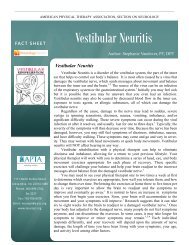Practice Guidelines for BPPV - Neurology Section
Practice Guidelines for BPPV - Neurology Section
Practice Guidelines for BPPV - Neurology Section
You also want an ePaper? Increase the reach of your titles
YUMPU automatically turns print PDFs into web optimized ePapers that Google loves.
Vestibular SIG Newsletter <strong>BPPV</strong> Special Edition<br />
1) the side on which the nystagmus is most intense during<br />
the SRT, and/or 2) the side opposite the direction of the<br />
spontaneous nystagmus in sitting, and/or 3) the side<br />
opposite the direction of the nystagmus <strong>for</strong> the SST. For<br />
the apogeotropic <strong>for</strong>m the involved side will be; 1) the side<br />
on which the nystagmus is less intense during the SRT,<br />
and/or 2) the side which the spontaneous nystagmus beats<br />
in sitting, and/or 3) side which the nystagmus beats during<br />
the SST.<br />
Head Shaking Induced Nystagmus (HSIN) may be an<br />
additional sign to localize side. The Head Shake Test<br />
involves rotating the head in upright several times at ~2Hz<br />
and then observing <strong>for</strong> nystagmus 1 . In both the geotropic<br />
and apogeotropic <strong>for</strong>ms HSIN will beat toward the healthy<br />
side (or away from the involved side) 1 . Califano and<br />
colleagues 1 found a positive nystagmus with fast phase<br />
beating away from the side of involvement in 40 out of 64<br />
(62.5%) of patients with the apogeotropic <strong>for</strong>m of HC<br />
<strong>BPPV</strong>. HSIN after the head shake test with HC <strong>BPPV</strong> has<br />
not been consistently described elsewhere in the literature.<br />
Asprella-Libonati 13 described slow head rotations may<br />
evoke a spontaneous horizontal nystagmus in some<br />
individuals who did not show an initial spontaneous<br />
nystagmus. De Stafano and colleagues 9 reported that<br />
individuals with spontaneous nystagmus associated with<br />
HC <strong>BPPV</strong> had negative head shaking tests. The head<br />
shake test may also convert apogeotropic to a geotropic<br />
<strong>for</strong>m in some cases 1 .<br />
Clinical considerations:<br />
There does not appear to be one method that will identify<br />
side of involvement in all patients with HC <strong>BPPV</strong>.<br />
Clinicians may be more successful identifying side, if they<br />
are familiar and able to utilize all of the tests described<br />
above. By adding the BLT (or HPT) to Asprella-<br />
Libonata’s recommendations 13 <strong>for</strong> side identification, the<br />
clinician has more flexibility in making an accurate<br />
diagnosis and can utilize these tests as needed to<br />
accommodate individual patient factors and presentations.<br />
Table 2 presents the rules <strong>for</strong> interpreting side of<br />
involvement based on the three additional<br />
findings/positional tests discussed above once the<br />
horizontal canal and <strong>for</strong>m of <strong>BPPV</strong> have been identified<br />
with the SRT. Interpreting HSIN was not included in the<br />
table, because consistent interpretations have not been<br />
reported in the literature. The other tests have stronger<br />
validity because they have been described and utilized by<br />
several independent clinical research groups. In this work<br />
the guidelines <strong>for</strong> interpretation are consistently described<br />
13<br />
and not difficult to follow.<br />
In addition, these tests should not take much time in the<br />
examination. Each test should only take about 1 minute<br />
to per<strong>for</strong>m. A likely order to per<strong>for</strong>m the test would be<br />
to 1) observe <strong>for</strong> spontaneous nystagmus and 2) per<strong>for</strong>m<br />
the BLT in upright sitting, 3) then move the patient into<br />
supine with the SST and 4) then per<strong>for</strong>m the SRT last.<br />
The biggest consideration is how many provocative tests<br />
a patient can tolerate during an examination period. Will<br />
per<strong>for</strong>ming the entire battery make the patient so<br />
uncom<strong>for</strong>table that they will not complete the exam or<br />
allow an intervention to be applied in a single session?<br />
Some researchers have discussed this issue and<br />
developed strategies to identify side of involvement with<br />
the least amount of provocation of symptoms. Asprella-<br />
Libonata, 13,15 Han et al 4 and Califano et al 1 have<br />
independently recommended per<strong>for</strong>ming SST together to<br />
the SRT, since the patient would have to go into supine<br />
position be<strong>for</strong>e the SRT. The results of these two tests<br />
will give side of involvement in a high proportion of<br />
patients. Asprella-Libonata, 13,15 and Califano et al 1 also<br />
suggest checking <strong>for</strong> spontaneous nystagmus prior to<br />
any maneuvers to add an additional piece of in<strong>for</strong>mation<br />
without over stimulating the individuals (See Asprella-<br />
Libonata recommendations above). Califano and<br />
colleagues had examined the results of all the signs and<br />
positional test reviewed here, in several individuals with<br />
HC <strong>BPPV</strong>, and felt the largest number of patients would<br />
only require spontaneous nystagmus, SST and SRT to<br />
determine side of involvement. Only in the “rare”<br />
conditions, when a side of involvement could not be<br />
determined, would they recommend returning patient to<br />
sitting and per<strong>for</strong>m BLT and the Head Shake test 1 .<br />
Alternatively, Lee and colleagues 2 found they could<br />
diagnosis side of involvement in 100% of patients with<br />
the BLT and the SRT alone.<br />
For best results these tests should be per<strong>for</strong>med in<br />
physical therapy setting with video goggles or Frenzel<br />
lenses, where fixation is removed and eye movements<br />
can more clearly be observed. In the research reviewed<br />
here all the signs and positional tests used infrared video<br />
systems to identify and measure nystagmus. The<br />
literature has not demonstrated how well the horizontal<br />
nystagmus in HC <strong>BPPV</strong> is observed with or without<br />
goggle systems that cannot measure nystagmus.<br />
However, horizontal nystagmus in SST can be seen in<br />
many individuals without goggles (based on personal<br />
experience).

















